What Types of Aluminum Trim Are Available?
Introduction
Are you wondering what types of aluminum trim are available for your next tiling or flooring project?
You’re not alone—many people share the same doubts when it comes to selecting the right aluminum trim.
Aluminum trims come in various designs, each with unique characteristics tailored to different needs.
Whether you're looking for an edge trim to protect your tiles or a decorative solution to finish off your project, it’s important to know your options.
This article will guide you through the most common types of aluminum trims available, including their designs, functions, and the key features that make them stand out.
From edge trims like round and L-shape to specialized trims like stair nosing and transition strips, we’ve got you covered.
Let’s dive into the details and clear up any confusion surrounding aluminum trim choices!

1) Aluminum Edge Tile Trims
Aluminum edge tile trims are designed to protect tile edges and enhance the aesthetics of your space.
These trims are widely used in floor decorations, stair edging, carpet transitions, wardrobe doors, corner finishes, and gusset decorations.
Material
Crafted from extruded aluminum, these trims are lightweight, strong, and resistant to corrosion, making them ideal for high-moisture areas like kitchens and bathrooms.
Function
The primary function is to protect tile edges from damage. Aluminum trims also provide a smooth, clean finish where tiles meet other surfaces, offering both protection and a polished look.
Application Scenarios
Aluminum edge trims are versatile and can be used in:
Floor Transitions: Between tiles and other materials like wood or carpet.
Stair Edging: For enhanced durability and safety.
Carpet Edges: Finishing where carpet meets tile.
Furniture & Wardrobe Edges: Giving a sleek, finished look.
Corner Edges: For sharp, neat corners in tiling.
Surface Treatment
Aluminum trims undergo treatments like:
Brushing: For a matte texture.
Anodizing: Enhances corrosion resistance and offers color options.
Electrophoresis: Provides a glossy, smooth finish.
Spraying: For various textures and colors.
Installation Method
Trims are installed using adhesives or mechanical fasteners (screws or nails) for secure placement.
Advantages
Lightweight and durable
Corrosion-resistant
Easy maintenance
Non-fading and long-lasting
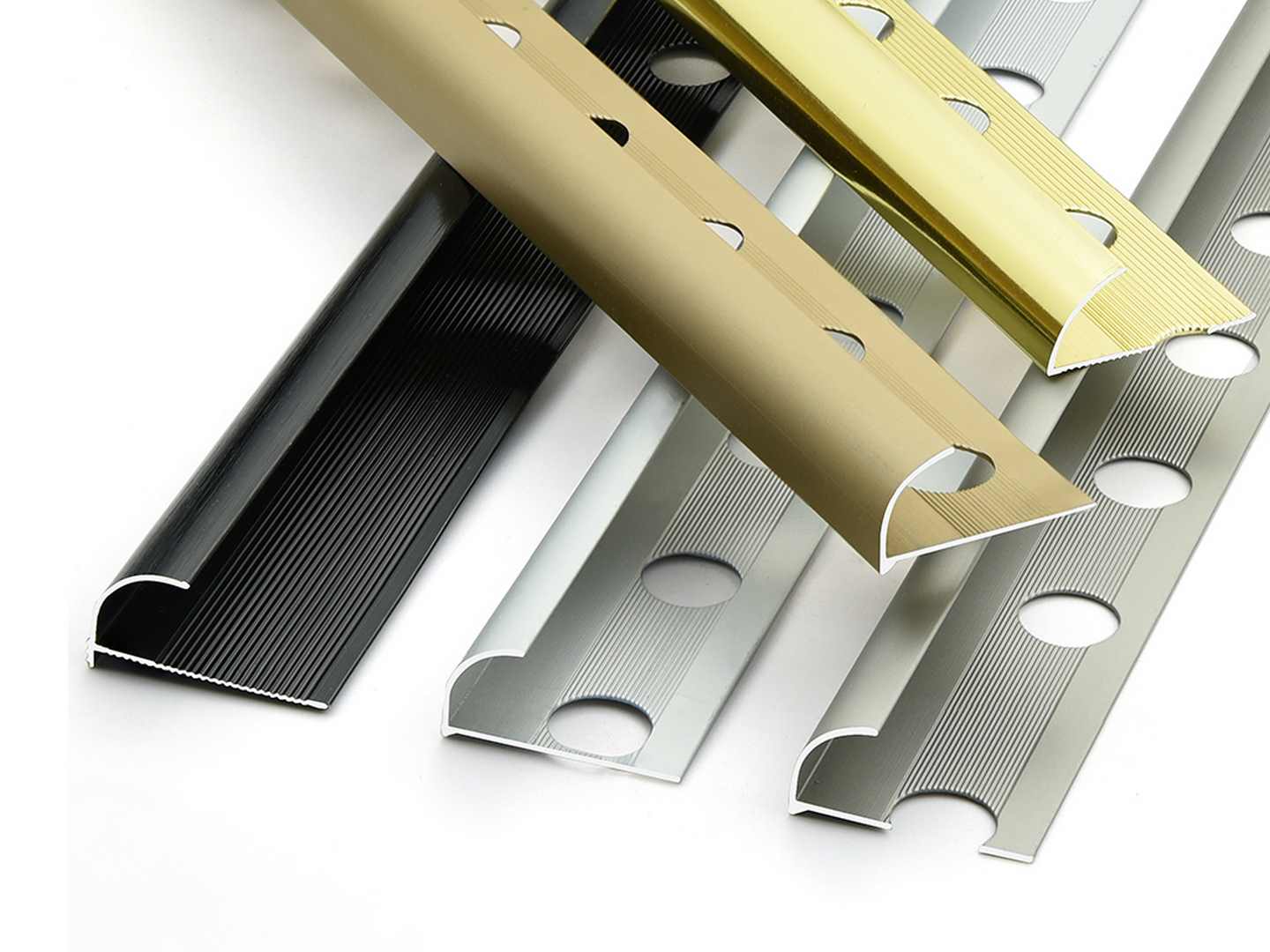
a) Round Shape Aluminum Trim
Round-shaped aluminum trims offer a smooth, soft transition between tile edges and adjoining surfaces.
This design is specifically crafted to minimize sharp edges, providing both a polished look and enhanced safety, especially in high-touch areas.
Material
Made from durable extruded aluminum, round-shaped trims are lightweight, corrosion-resistant, and long-lasting. Their smooth, rounded edges help prevent accidental cuts or abrasions, making them ideal for use in spaces where safety is a priority.
Function
The primary function of the round shape aluminum trim is to soften the tile edge, eliminating sharp corners that could potentially cause harm. This makes it perfect for areas like bathtubs, kitchen countertops, and other spaces with frequent contact.
Application Scenarios
- Bathroom: Perfect for bathtub edges or shower walls, where safety is critical.
- Kitchen: Ideal for countertop edges, protecting users from sharp tile corners.
- Living Areas: Can be used for softening the edge of tile walls or any area requiring a smooth, non-hazardous finish.
Surface Treatment
Round aluminum trims can be anodized for corrosion resistance, brushed for a matte finish, or sprayed to match a wide range of décor styles. These treatments ensure a sleek, durable appearance that lasts.
Installation Method
These trims can be easily installed using adhesive bonding or mechanical fasteners, depending on the project’s requirements.
Advantages
- Enhances safety by eliminating sharp corners.
- Offers a smooth, polished aesthetic.
- Perfect for high-traffic areas where safety is essential.
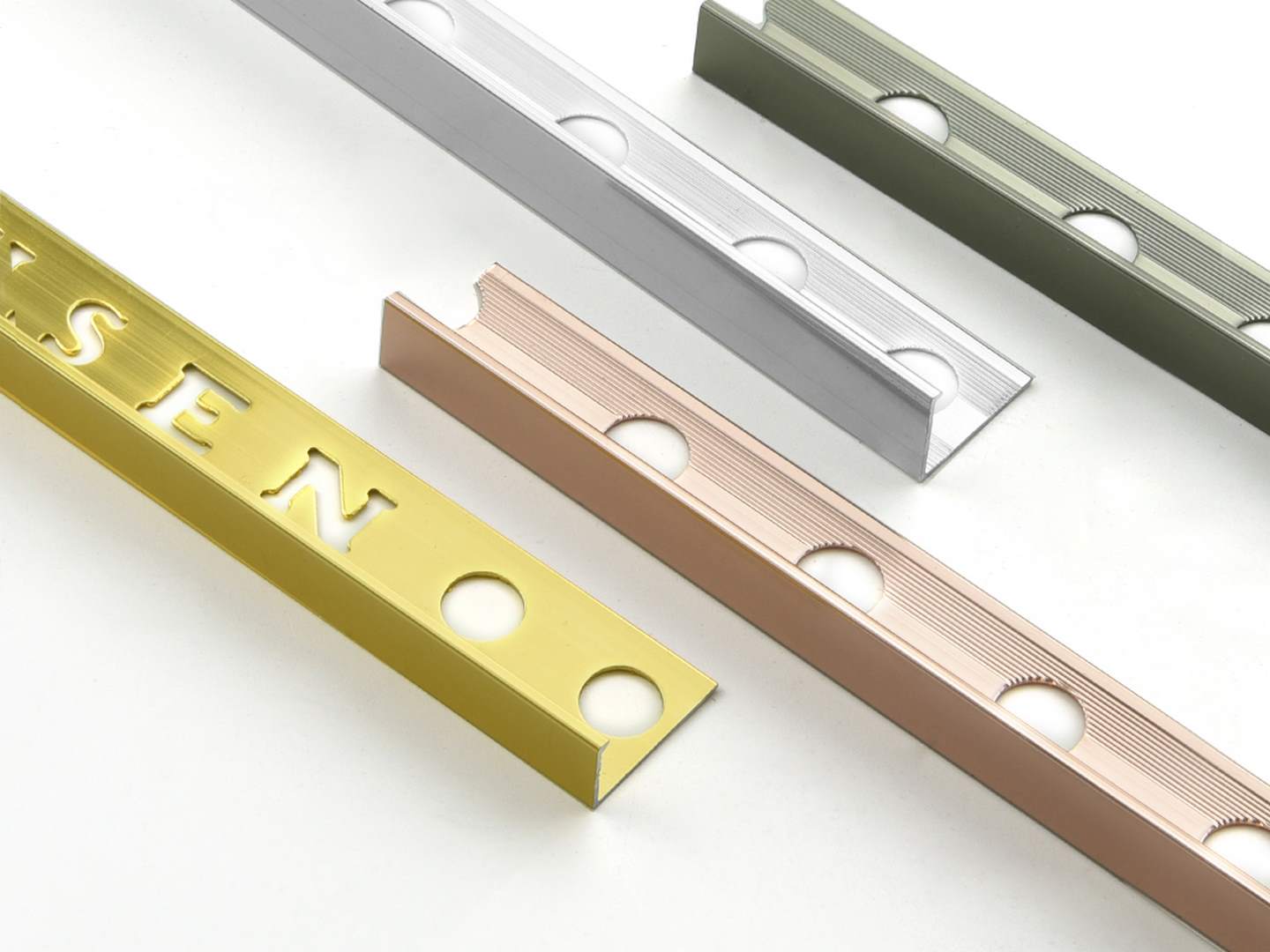
b) L Shape Aluminum Trim
L-shaped aluminum trims are designed to protect the edges and corners of tiles while adding a sharp, clean finish.
These trims are a popular choice for modern designs that emphasize sleek lines and minimalist aesthetics.
They’re versatile and functional, making them a preferred option for a variety of tile installations.
Material
Manufactured from extruded aluminum, L-shaped trims are lightweight yet strong, providing excellent protection for tile edges. The aluminum's corrosion resistance ensures durability, even in high-moisture areas like kitchens and bathrooms.
Function
The L-shaped trim functions as both a protective and decorative element. It safeguards tile edges and corners from chipping, cracking, or other forms of damage. The straight edge design aligns perfectly with modern architectural trends, delivering a polished and professional finish.
Application Scenarios
Tile Backsplashes: Used to frame and protect the edges of tiled kitchen backsplashes, ensuring a seamless and modern appearance.
Window Sills: Perfect for finishing and protecting tiled window sills, creating clean lines that complement minimalist interiors.
Corners and Transitions: Ideal for protecting and finishing tile edges at corners and transition points in walls and floors.
Surface Treatment
L-shaped trims can be treated with:
Anodizing: For improved durability and a variety of color options.
Brushing: For a subtle matte finish.
Powder Coating: To match diverse interior styles with customizable colors.
Installation Method
These trims are installed by embedding them into the tile adhesive during the tiling process. Alternatively, screws or nails may be used for more secure applications in certain settings.
Advantages
Protects edges and corners from damage.
Creates sharp, clean lines for modern aesthetics.
Highly durable and resistant to moisture and wear.
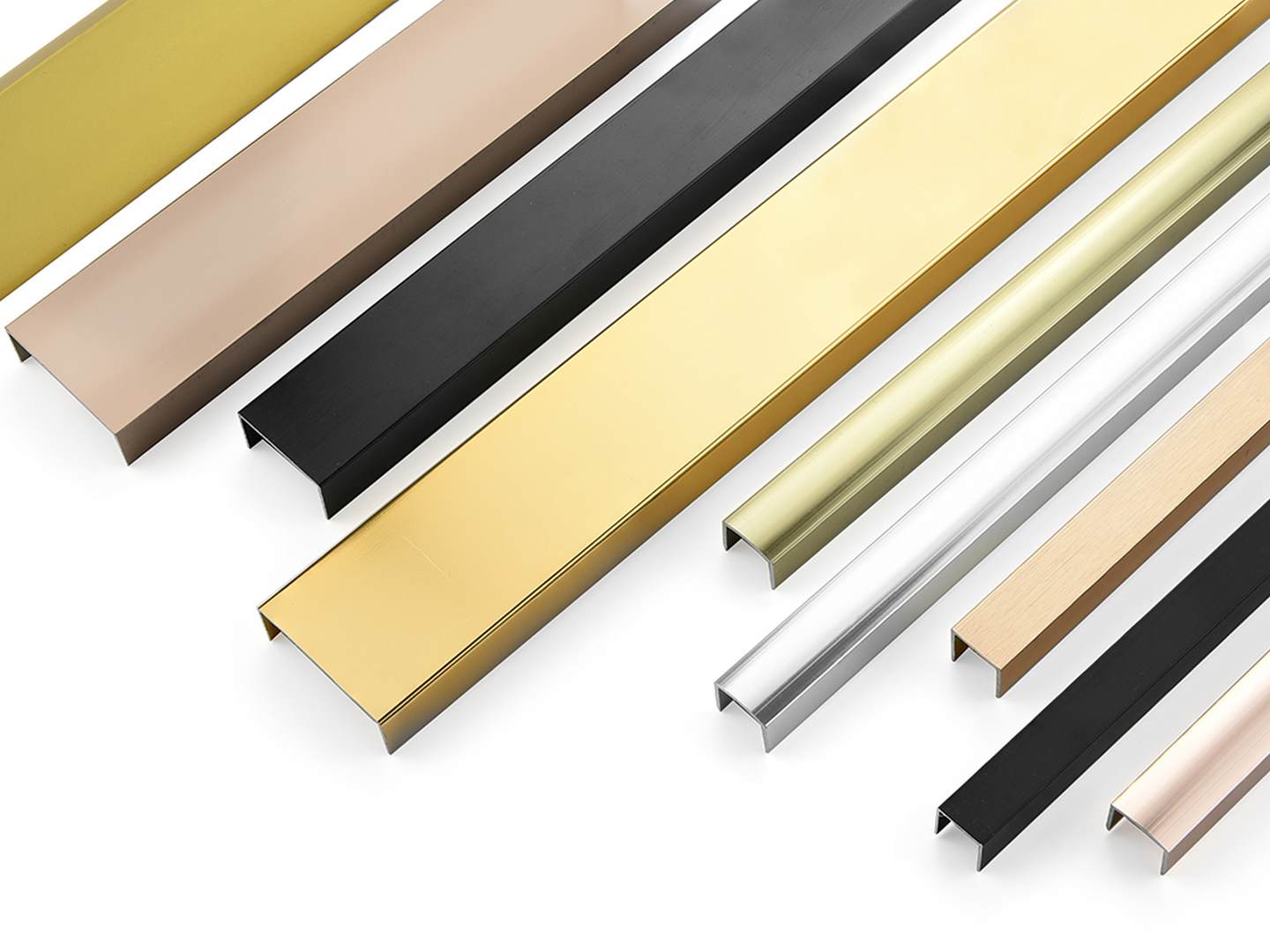
c) U Shape Aluminum Trim
U-shaped aluminum trims are narrow and highly decorative, designed to add elegance and functionality to tile installations.
They are often used to divide wall surfaces, create visual accents, or provide a color and texture contrast.
Material
Made from extruded aluminum, U-shaped trims are lightweight, durable, and resistant to corrosion, making them suitable for both indoor and outdoor applications.
Function
These trims serve as decorative dividers or accents, breaking up large tiled surfaces while adding dimension and style. They can also act as separators for different tile colors or materials.
Application Scenarios
Wall Dividers: Adds clean, modern lines to large tiled walls.
Focal Points: Enhances visual appeal around mirrors or backsplashes.
Contrast Design: Perfect for pairing contrasting tile colors or textures.
Surface Treatment
Common finishes include anodizing (for color and durability), brushing (for a matte texture), and spraying (for custom colors).
Installation Method
Installed using adhesive during the tiling process or secured with fasteners for additional stability.
Advantages
Decorative and functional.
Long-lasting and corrosion-resistant.
Perfect for enhancing tile design aesthetics.
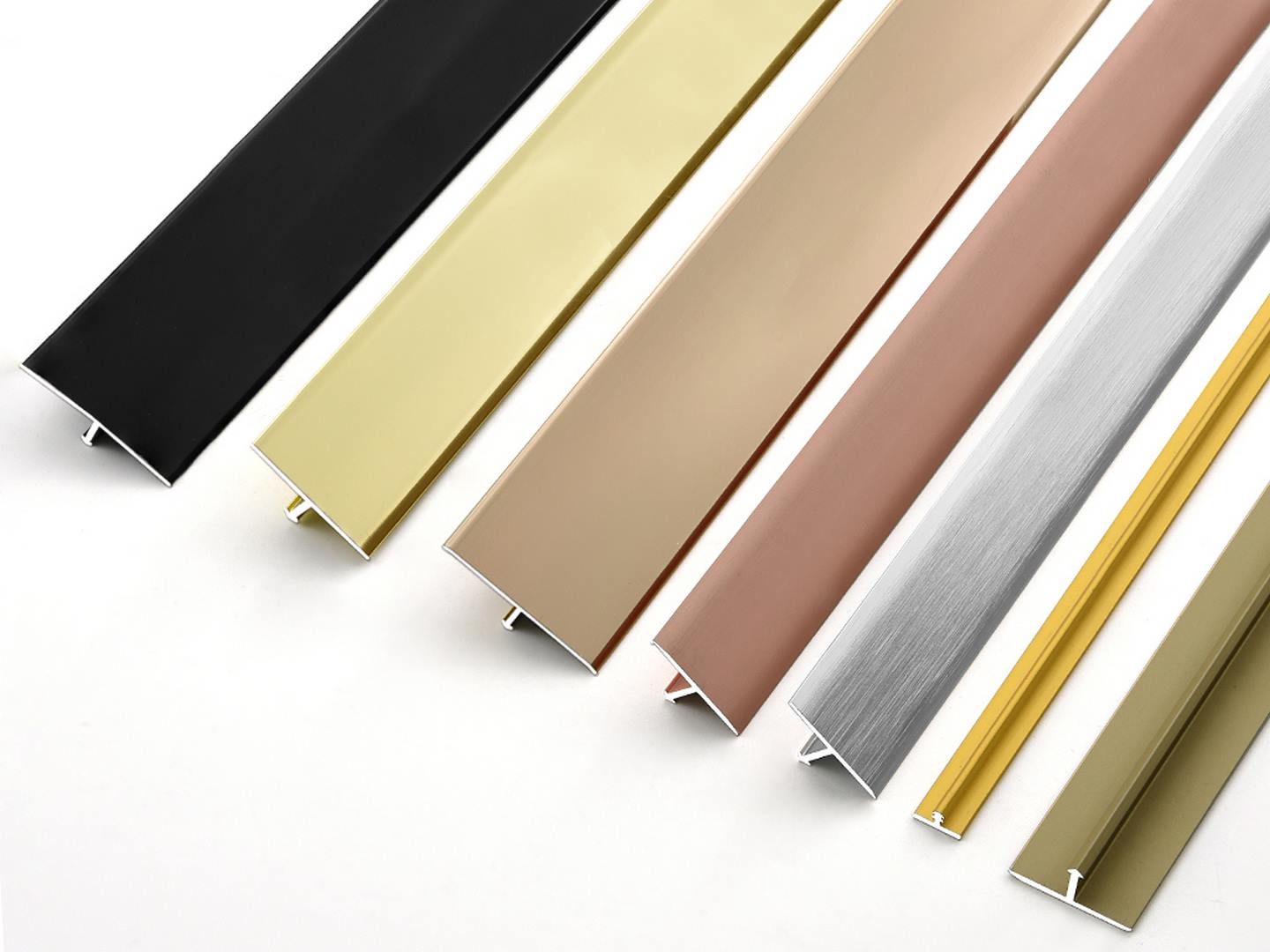
d) T Shape Aluminum Trim
T-shaped aluminum tile trim is designed for seamless transitions between hard surface flooring materials of the same height.
It provides both protection and aesthetic appeal by covering floor edges, preventing wear and tear in daily use.
Material
T-shaped trims are made from extruded aluminum, offering lightweight durability, corrosion resistance, and long-term performance. These properties make them suitable for both residential and commercial flooring projects.
Function
The primary purpose of T-shaped aluminum trims is to create smooth transitions between adjoining floors of the same height. They protect the edges of the flooring from damage, reduce the risk of tripping, and enhance the appearance of floor transitions.
Application Scenarios
Floor Transitions: Perfect for connecting tiled floors to other hard surfaces like wood, laminate, or stone.
Retrofitting: Suitable for upgrading existing installations to protect worn edges.
New Tile Installations: Used during tiling projects to ensure long-lasting edge protection.
Surface Treatment
T-shaped trims are available with various finishes, including
Anodizing: Adds durability and offers color options.
Brushing: Provides a matte, textured finish.
Spraying: Allows for custom colors to match the flooring style.
Installation Method
T trims can be installed with adhesives for seamless integration or mechanically secured for extra stability during retrofitting.
Advantages
Ensures smooth floor transitions.
Protects floor edges from damage.
Enhances aesthetics and reduces tripping hazards.
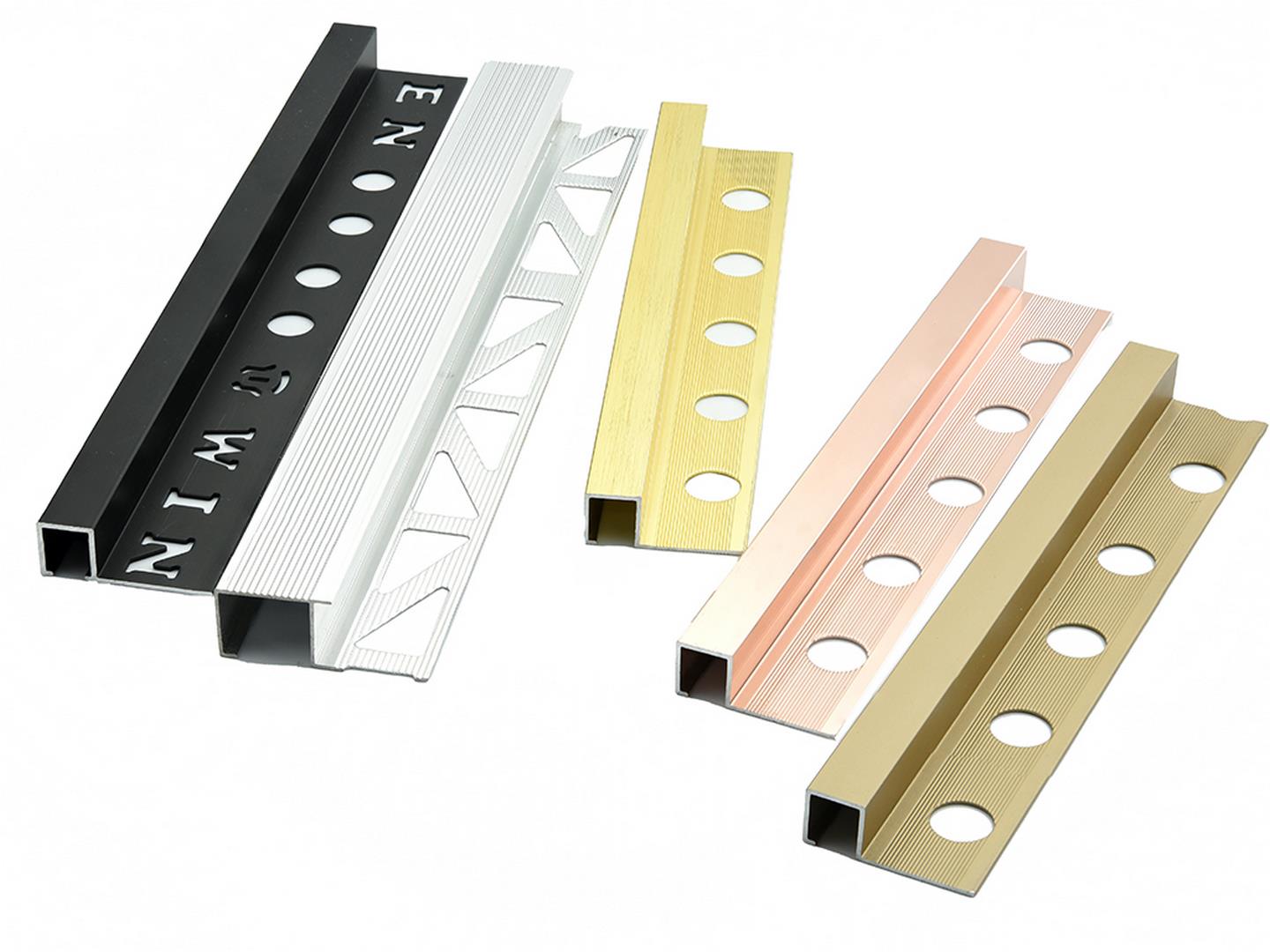
e) Square Shape Aluminum Trim
Square-shaped aluminum trims are designed to protect and decorate the edges of tiles, providing sharp, right-angled corners for a modern and minimalist aesthetic.
They add a sleek finishing touch while preventing damage to vulnerable edges.
Material
Made from extruded aluminum, these trims are lightweight, durable, and corrosion-resistant, making them suitable for both residential and commercial spaces.
Function
The trims safeguard tile edges from chipping and wear while emphasizing clean lines and contemporary design.
Application Scenarios
Corner Protection: Shields tile edges at corners from damage.
Decorative Accents: Frames tiled walls, backsplashes, or countertops for a polished finish.
Modern Interiors: Complements minimalist spaces with clean, angular aesthetics.
Surface Treatment
Available in finishes like:
Anodizing for corrosion resistance and metallic hues.
Brushing for a matte, modern texture.
Spraying for customizable colors.
Installation Method
Installed during tiling with adhesives or fasteners to ensure alignment and durability.
Advantages
Provides edge protection.
Enhances modern, minimalist designs.
Long-lasting and low maintenance.
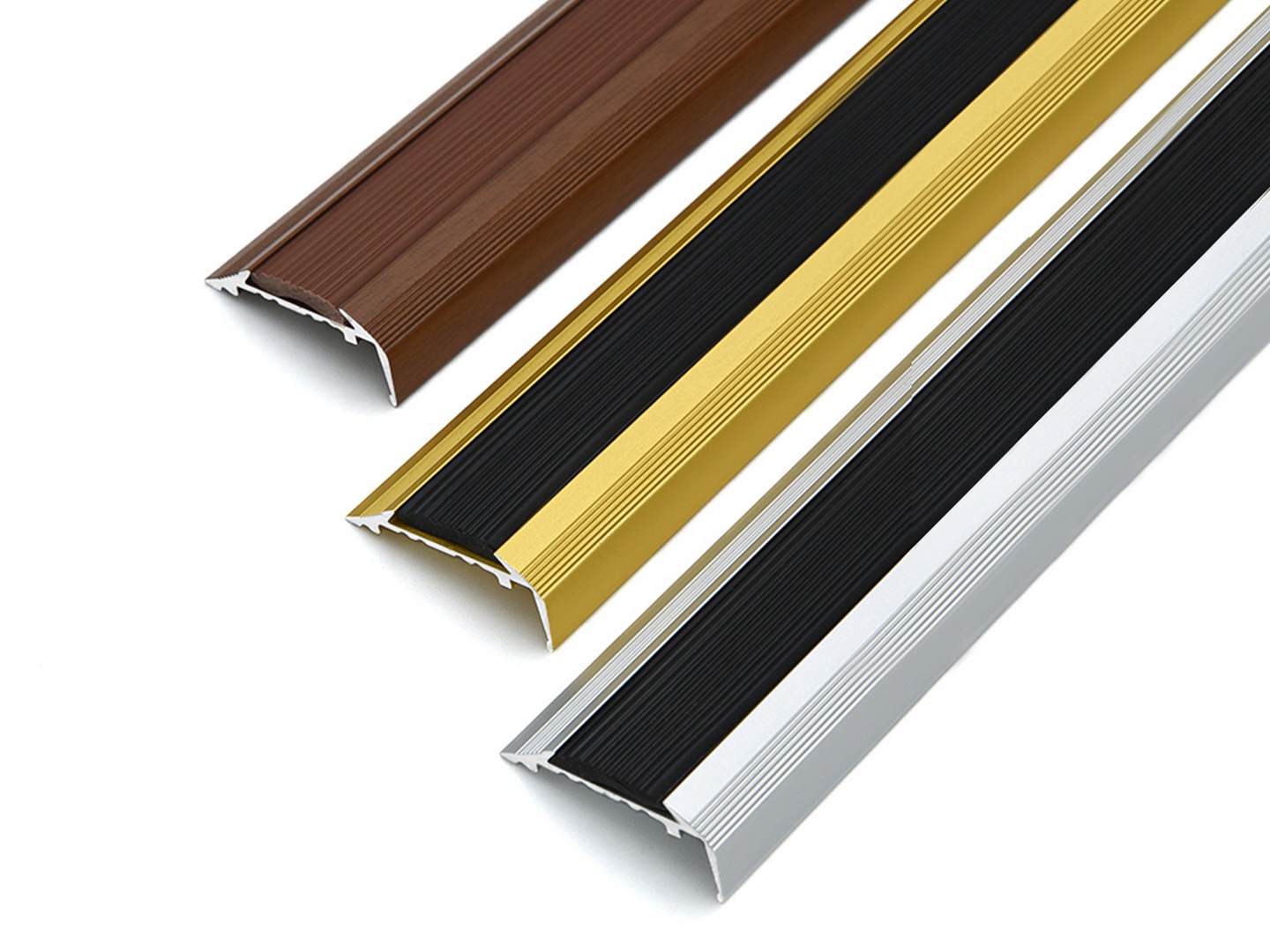
f) Aluminum Stair Nosing
Aluminum stair nosing is designed to protect stair edges, enhance safety, and improve aesthetics.
Made from extruded aluminum, it is lightweight, durable, and corrosion-resistant, making it ideal for residential, commercial, and industrial use.
Function
It prevents damage to stair edges caused by frequent use, provides anti-slip properties to reduce accidents, and adds a polished, decorative finish to the staircase.
Application Scenarios
Residential: Protects and decorates home stairs.
Commercial: Ideal for high-traffic areas in offices or shopping malls.
Industrial: Ensures safety in factories and warehouses.
Surface Treatment
Anodizing: For durability and metallic finishes.
Brushing: Matte surface for modern designs.
Spraying: Custom colors for various styles.
Installation Method
Installed with adhesives or screws to securely fit and withstand heavy use.
Advantages
Protects stair edges.
Reduces slipping risks.
Durable and visually appealing.
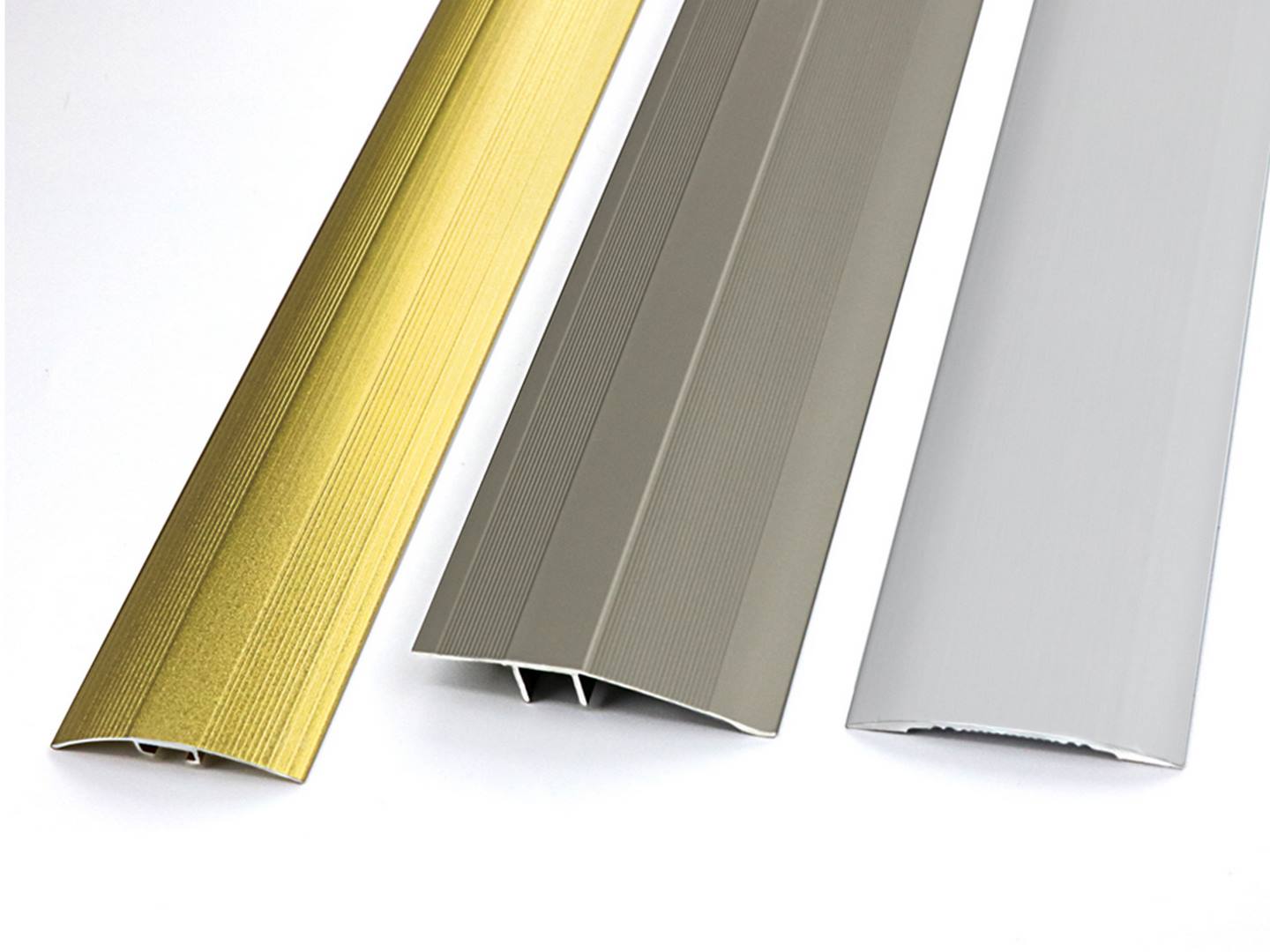
2) Aluminum Transition Connector Strip
The aluminum transition connector strip is a versatile building accessory commonly used in flooring projects to ensure a smooth and safe transition between two different types of flooring materials.
It provides both functional and decorative benefits.
Material
Made from extruded aluminum, transition strips are lightweight, highly durable, and resistant to wear, making them ideal for areas with heavy foot traffic. The material’s corrosion-resistant properties ensure longevity in both residential and commercial applications.
Function
The primary purpose of the transition strip is to connect and transition two floors of different heights, materials, or colors. It bridges gaps between tiles and wooden floors, carpets and stones, or other flooring combinations. It prevents edges from curling, cracking, or lifting, reducing the risk of tripping while maintaining a cohesive and professional appearance.
Application Scenarios
Residential: Used in living spaces to transition between tiled and carpeted areas or wooden flooring.
Commercial: Ideal for offices, hotels, or retail stores where different flooring materials meet.
High-Traffic Areas: Provides durability and safety for public spaces.
Surface Treatment
Anodizing: Adds durability and color options.
Brushing: Provides a matte, textured finish.
Spraying: Custom colors for various interior styles.
Installation Method
Transition strips can be installed using adhesives for a seamless look or secured with screws for additional stability in high-traffic areas.
Advantages
Smooth transitions between floors.
Prevents edge damage and tripping hazards.
Enhances floor aesthetics and ensures durability.
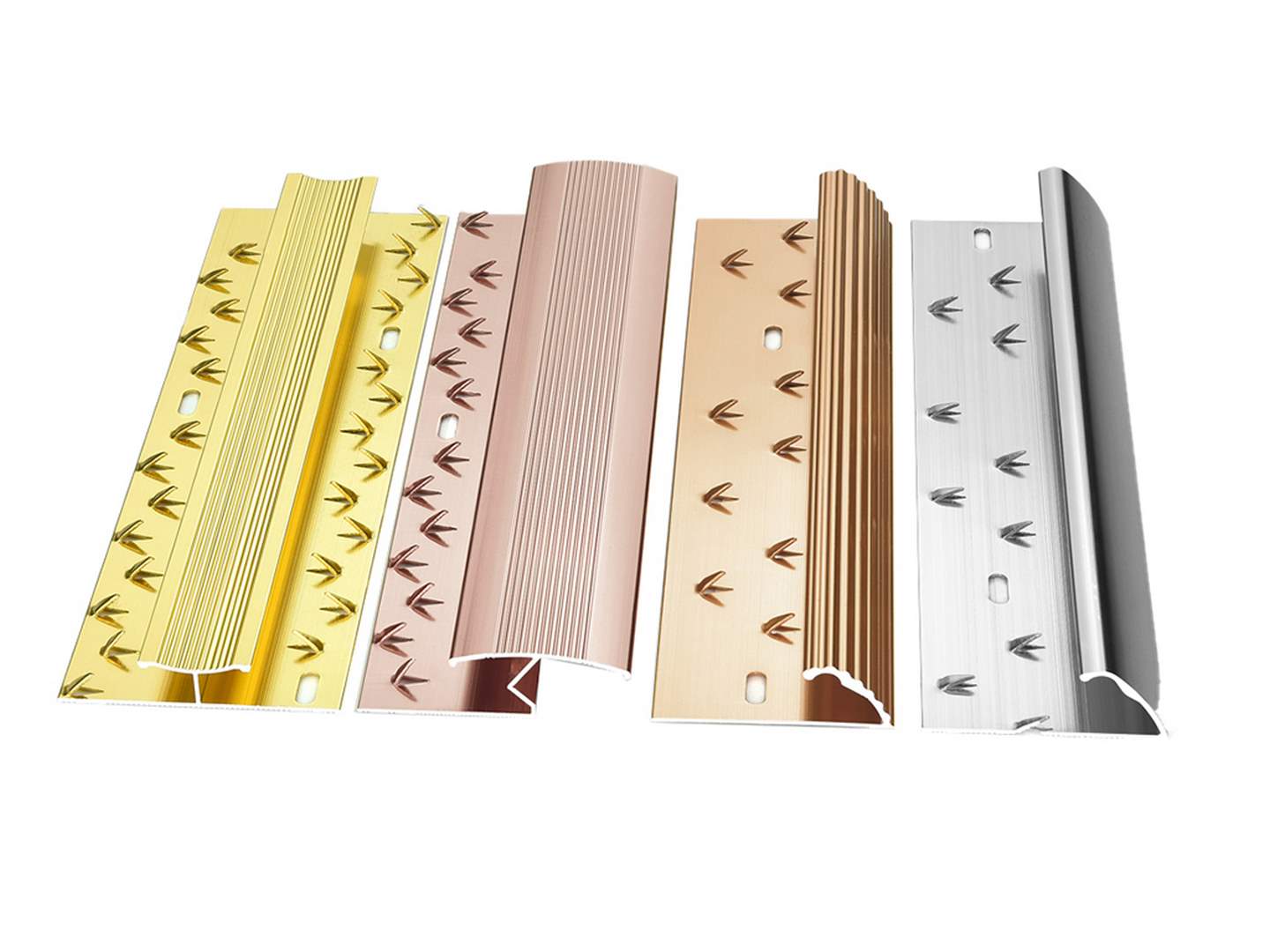
3) Aluminum Carpet Trim
Aluminum carpet trim is an essential accessory designed for the protection and enhancement of carpet installations.
Made from high-quality aluminum alloy, it secures carpet edges, prevents damage, and ensures a polished, professional look.
Material
Manufactured from extruded aluminum, carpet trims are lightweight, durable, and corrosion-resistant, making them ideal for both residential and commercial use.
Function
The primary function of aluminum carpet trim is to decorate and secure the edges of carpets while providing a smooth, seamless transition to adjoining flooring materials. It prevents the edges of the carpet from curling, wearing, or detaching, enhancing safety and durability.
Application Scenarios
Residential: Used in living rooms or bedrooms to protect carpet edges and maintain aesthetics.
Commercial: Ideal for offices, hotels, or retail spaces to handle high foot traffic and maintain a polished appearance.
Public Spaces: Ensures safety and durability in areas like conference halls or airports.
Types of Aluminum Carpet Trim
L-Type: For edge protection and finishing where the carpet meets other flooring.
T-Type: For transitions between carpet and hard flooring of the same height.
Ramp Type: Provides a smooth incline for transitions between carpets and floors of different heights.
Embedded Type: Secured beneath the carpet for hidden edge protection.
Surface Treatment
Anodizing: Enhances corrosion resistance and offers a range of colors.
Brushing: Provides a matte, textured finish.
Spraying: Allows for custom color matching.
Installation Method
Carpet trims can be installed using adhesives or screws, depending on the type and location of use.
Advantages
Prevents carpet edges from curling or fraying.
Enhances safety and durability.
Offers a sleek, professional finish to carpeted spaces.

4) Customize Aluminum Trims
Customized aluminum trims are tailored to meet specific project needs, offering flexibility in size, shape, and finish.
Made from durable extruded aluminum, they provide both decorative and functional benefits.
Ideal for unique layouts, high-end designs, or branding, they feature finishes like anodizing, powder coating, or polishing.
Installation uses adhesives or screws, ensuring seamless integration.
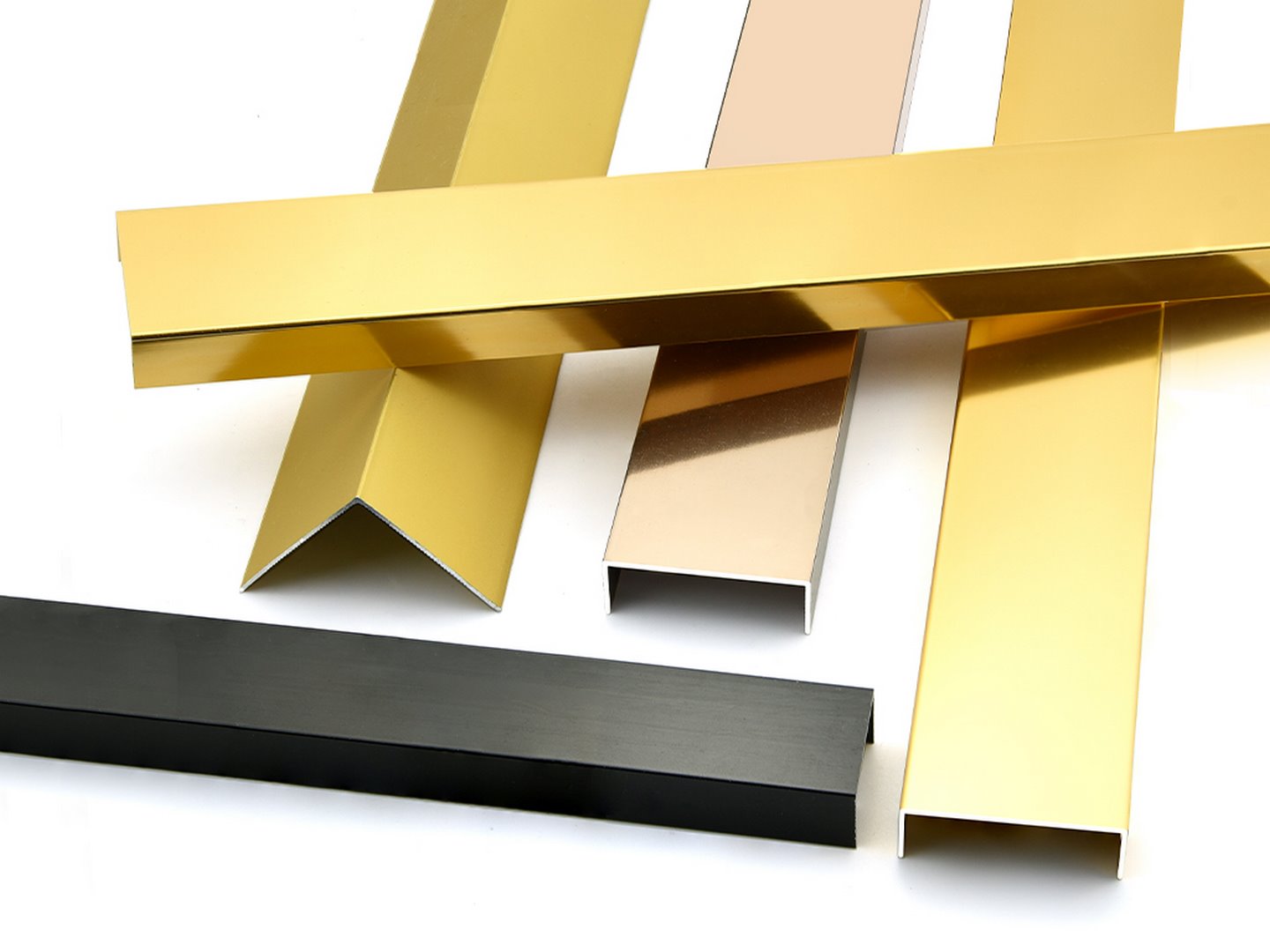
Conclusion
This article has explored the various types of aluminum trims available, including Aluminum Edge Tile Trims (round, L-shape, U-shape, T-shape, square shape, and stair nosing), Aluminum Transition Connector Strips, Aluminum Carpet Trims, and Customizable Aluminum Trims.
Each type is designed to address specific needs in flooring and tile projects, providing solutions for protection, decoration, and safety.
Aluminum trims solve common challenges, such as protecting tile and floor edges from damage, creating smooth transitions between different materials, and preventing hazards like tripping or slipping.
They also enhance the visual appeal of floors and walls, adding a polished, professional finish to any space.
Whether for residential, commercial, or industrial use, aluminum trims combine durability, versatility, and aesthetics to meet the demands of modern design and functionality.
Welcome to know more detailed information about products in WINSEN.
